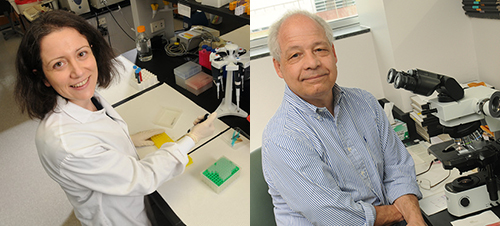Public health agencies and physicians would gain access to accurate, rapid dip-stick test that could give results similar to a pregnancy test
Tuberculosis is a major killer that ranks alongside HIV/AIDS as a leading cause of death worldwide. This deadly disease takes the lives of more than a million people each year. And, unfortunately, traditional medical laboratory testing using X-rays, blood/skin/sputum specimens, or the new molecular diagnostic systems can be time consuming and expensive.
Now, scientists at George Mason University (GMU) in Virginia have developed a urine test for tuberculosis (TB) that could lead to a dip-stick technology that would accurately and rapidly diagnose the deadly lung disease. Similar to a pregnancy test, if successfully developed for use in clinical settings, the dip-stick could not only enable public health agencies to test for TB more effectively, but also allow primary care physicians and other doctors to easily test their patients for TB at the point of care. However, it also could mean clinical laboratories might find their participation.
Nearly All TB Deaths Occur in Resource Strapped Areas
Such a breakthrough would certainly be a boon to public health and global healthcare, especially in resource strapped areas of the world. According to the World Health Organization (WHO), more than 95% of the 1.7 million TB deaths each year occur in low- and middle-income countries. This is one reason why an inexpensive and easy-to-use detection method for diagnosing the lung disease has long been sought. TB is curable, particularly if diagnosed early.
With that goal in mind, an international team led by Alessandra Luchini, PhD, Associate Professor at GMU, and Lance Liotta, PhD, MD, co-director and co-founder of the GMU Center for Applied Proteomics and Molecular Medicine, developed the potentially revolutionary urine test that uses nanotechnology to measure a sugar molecule in urine that identifies TB with a high degree of accuracy. The scientists published their results in Science Translational Magazine.

George Mason University scientists Alessandra Luchini, PhD (above left), and Lance Liotta, MD, PhD (above right), head an international team that has developed a nanotechnology that may lead to a simple dipstick urine test to detect tuberculosis. Such a test could greatly impact medical laboratories by reducing the need for traditional lab tests. (Photo copyrights: George Mason University.)
While past attempts at developing an accurate urine test for TB failed to reliably detect low concentrations of the sugar entity lipoarabinomannan (LAM) in HIV-negative, TB-infected patients, the GMU team developed a technology capable of doing so.
According to New Scientist, the GMU team’s test “uses tiny molecular cages embedded with a special dye that can catch and trap these sugar molecules. This makes the test capable of detecting the sugar at low concentrations, making the technique as much as 1,000 times more accurate [than] previous methods for detecting TB in urine.”
“We can measure now what could never be measured before,” Liotta noted in a news release.
World Health Organization Recommends Not Using Serodiagnostic Blood Tests
Common methods to detect TB currently include microscopy of sputum samples—a fast and accurate but expensive detection method (that also can diagnosis drug resistant disease)—or a skin test. A third test for TB, an Interferon-Gamma Release Assay, provides results in less than 24 hours but cannot distinguish between active and latent infection. In 2011, the WHO issued a Policy Recommendation urging countries to stop using serodiagnostic blood tests to diagnose TB, calling these tests unreliable and inaccurate. X-rays, meanwhile, detect only advanced lung damage.
In the GMU study, 48 Peruvian patients were chosen, all with active pulmonary TB, none of whom was infected with HIV or previously had received treatment for TB. According to the research, TB infections were detected with greater than 95% sensitivity, with TB-positive, HIV-negative patients having detectably higher concentrations of LAM in their urine compared to the controls. Patients who had more advanced disease also had elevated LAM concentrations. Eight of nine patients who were smear-negative and culture-positive for TB tested positive for urinary LAM.
“The technology can be configured in a variety of formats to detect a panel of previously undetectable very-low-abundance TB urinary analytes … This technology has broad implications for pulmonary TB screening, transmission control, and treatment management for HIV-negative patients,” the study’s authors told Science.
While The Scientist reports the GMU urine test gives results in about 12 hours, Luchini’s goal is for that timeframe to be dramatically shortened as the test is refined.
“We showed that our technology could be used to measure several different kinds of markers for TB in the urine and could be configured as a rapid test similar to a pregnancy test,” Luchini said in a GMU news release.
According to the university, GMU researchers will continue their work in Peru, where students will begin testing hundreds of patients as part of a research study. Grants from the National Institutes of Health and the Bill and Melinda Gates Foundation are funding their work. Luchini told New Scientist her goal is to make their TB urine test easier to use and to test it on thousands more people.
If successful, she predicts the test could be commercially available for physicians and clinical laboratories to use within three years. GMU’s biotechnology partner Ceres Nanosciences will be commercializing the technology, with the aim of making the test available worldwide, the university said in a statement.
—Andrea Downing Peck
Related Information:
TB, or Not TB? At Last, a Urine Test Can Diagnose It Quickly
Mason Scientists Develop Nanotechnology-based Urine Test that Could Lead to Early TB Detection
Urine Test for TB Yields Results in 12 Hours
Tuberculosis Serodiagnostic Tests Policy Statement 2011



